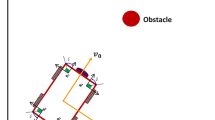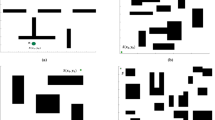Abstract
The current research aims to enhance the humanoid NAO’s ability to plan their overall routes through static and dynamic terrains. The strategy is based on the fusion of the modified hyperbolic gravitational search algorithm and dynamic window approach (DWA) for the navigation of humanoids in various complex terrains. While the updated GSA enhances the fundamental design of basic GSA in terms of exploration and exploitation, the DWA aids in enhancing navigational velocity. The method helps improve overall computational time and, hence, the cost associated with path planning. The modifications to the hyperbolic GSA are carried out by introducing the chaotic neural oscillators to carry out a chaotic search in the immediate surroundings. Three different neural oscillators are chosen and applied to the path planning. The approach helps overcome the cons when the masses/agents show lesser movements in the population. Path planning is carried out in simulation and experimental terrains with and without dynamic obstacles. The proposed MGSA-DWA showed a significant improvement of more than 5% in the path length and time compared with the GSA-DWA. When merged with the Dining Philosophy model, the proposed model effectively avoided dynamic obstacles. The deviation between the simulation and experimental arena was below 6%. The robustness of the proposed model was obtained by comparing it with existing vision-based and other sensor-based approaches. Compared with the vision-based approach, the proposed model effectively traced an optimal path with a 30% improvement in time. The model greatly outperformed other sensor-based methods in a similar scenario.















Similar content being viewed by others
Data availability
Not applicable.
References
Munawar HS, Inam H, Ullah F et al (2021) Towards smart healthcare: UAV-based optimized path planning for delivering COVID-19 self-testing kits using cutting edge technologies. Sustain 13:10426. https://doi.org/10.3390/SU131810426
Chen H, Thomas F, Xiongzi L (2008) Automated industrial robot path planning for spray painting a process: a review. In: 4th IEEE Conf Autom Sci Eng CASE pp 522–527 https://doi.org/10.1109/COASE.2008.4626515
Basiri A, Mariani V, Silano G et al (2022) A survey on the application of path-planning algorithms for multi-rotor UAVs in precision agriculture. J Navig 75:364–383. https://doi.org/10.1017/S0373463321000825
Sabiha AD, Kamel MA, Said E, Hussein WM (2022) Real-time path planning for autonomous vehicle based on teaching–learning-based optimization. Intell Serv Robot 15:381–398. https://doi.org/10.1007/S11370-022-00429-3/FIGURES/19
Rashedi E, Nezamabadi-pour H, Saryazdi S (2009) GSA: a gravitational search algorithm. Inf Sci (Ny) 179:2232–2248. https://doi.org/10.1016/J.INS.2009.03.004
Vikas, Parhi DR, Kashyap AK, Deepak BBVL (2023) Gravity search algorithm-based path planning of single humanoid based on the study of different artificial intelligence techniques. pp 913–921. https://doi.org/10.1007/978-981-19-4606-6_83/COVER
Vikas, Parhi DR, Kashyap AK (2023) Humanoid robot path planning using memory-based gravity search algorithm and enhanced differential evolution approach in a complex environment. Expert Syst Appl 215:119423. https://doi.org/10.1016/J.ESWA.2022.119423
Huang L, Qin C (2019) A novel modified gravitational search algorithm for the real world optimization problem. Int J Mach Learn Cybern 10:2993–3002. https://doi.org/10.1007/S13042-018-00917-Y/FIGURES/6
Pei L, Haibin D (2012) Path planning of unmanned aerial vehicle based on improved gravitational search algorithm. Sci China Technol Sci 55:2712–2719. https://doi.org/10.1007/s11431-012-4890-x
Mirjalili S, Lewis A (2014) Adaptive gbest-guided gravitational search algorithm. Neural Comput Appl 25:1569–1584. https://doi.org/10.1007/S00521-014-1640-Y/TABLES/10
Younes Z, Alhamrouni I, Mekhilef S, Reyasudin M (2021) A memory-based gravitational search algorithm for solving economic dispatch problem in micro-grid. Ain Shams Eng J 12:1985–1994. https://doi.org/10.1016/J.ASEJ.2020.10.021
Bohat VK, Arya KV (2018) An effective gbest-guided gravitational search algorithm for real-parameter optimization and its application in training of feedforward neural networks. Knowl Based Syst 143:192–207. https://doi.org/10.1016/J.KNOSYS.2017.12.017
Xu H, Jiang S, Zhang A (2021) Path planning for unmanned aerial vehicle using a mix-strategy-based gravitational search algorithm. IEEE Access 9:57033–57045. https://doi.org/10.1109/ACCESS.2021.3072796
Khan TA, Ling SH (2021) A novel hybrid gravitational search particle swarm optimization algorithm. Eng Appl Artif Intell 102:104263. https://doi.org/10.1016/J.ENGAPPAI.2021.104263
Shanker R, Bhattacharya M (2020) An automated computer-aided diagnosis system for classification of MR images using texture features and gbest-guided gravitational search algorithm. Biocybern Biomed Eng 40:815–835. https://doi.org/10.1016/J.BBE.2020.03.003
Chakraborti T, Das Sharma K, Chatterjee A (2014) A novel local extrema based gravitational search algorithm and its application in face recognition using one training image per class. Eng Appl Artif Intell 34:13–22. https://doi.org/10.1016/J.ENGAPPAI.2014.05.002
Das PK, Behera HS, Jena PK, Panigrahi BK (2016) Multi-robot path planning in a dynamic environment using improved gravitational search algorithm. J Electr Syst Inf Technol 3:295–313. https://doi.org/10.1016/J.JESIT.2015.12.003
Khanesar MA, Bansal R, Martínez-Arellano G, Branson DT (2020) XOR binary gravitational search algorithm with repository: industry 4.0 applications. Appl Sci 10:6451. https://doi.org/10.3390/APP10186451
Panda MR, Das PK, Pradhan SK, Behera HS (2016) An improved gravitational search algorithm and its performance analysis for multi-robot path planning. In: Proc - 2015 Int Conf Man Mach Interfacing, MAMI 2015. https://doi.org/10.1109/MAMI.2015.7456577
Birx DL, Pipenberg SJ (1992) Chaotic oscillators and complex mapping feed forward networks (CMFFNS) for signal detection in noisy environments. Proc Int J Conf Neural Netw 2:881–888. https://doi.org/10.1109/IJCNN.1992.226876
Yu X, Zhao Q, Lin Q, Wang T (2023) A grey wolf optimizer-based chaotic gravitational search algorithm for global optimization. J Supercomput 79(3):2691–2739. https://doi.org/10.1007/s11227-022-04754-3
Lamamra K, Vaidyanathan S, Azar AT, Ben SC (2017) Chaotic system modelling using a neural network with optimized structure. Fract Order Control Synchron Chaotic Syst. https://doi.org/10.1007/978-3-319-50249-6_29/COVER
Fox D, Burgard W, Thrun S (1997) The dynamic window approach to collision avoidance. IEEE Robot Autom Mag 4:23–33. https://doi.org/10.1109/100.580977
Lai X, Wu D, Wu D et al (2022) Enhanced DWA algorithm for local path planning of mobile robot. Ind Rob Ahead Print. https://doi.org/10.1108/IR-05-2022-0130/FULL/PDF
Ballesteros J, Urdiales C, Velasco ABM, Ramos-Jimenez G (2017) A biomimetical dynamic window approach to navigation for collaborative control. IEEE Trans Hum Mach Syst 47:1123–1133. https://doi.org/10.1109/THMS.2017.2700633
Cai P, Deng X (2020) Incipient fault detection for nonlinear processes based on dynamic multi-block probability related kernel principal component analysis. ISA Trans 105:210–220. https://doi.org/10.1016/J.ISATRA.2020.05.029
Kang Y, De Lima DA, Victorino AC (2015) Dynamic obstacles avoidance based on image-based dynamic window approach for human-vehicle interaction. In: IEEE Intell Veh Symp Proc 2015-August, pp 77–82 https://doi.org/10.1109/IVS.2015.7225666
Özdemir A, Bogosyan SO (2023) Gap based elastic trees as a novel approach for fast and reliable obstacle avoidance for UGVs. J Intell Rob Syst 107(1):9. https://doi.org/10.1007/s10846-022-01792-0
Kobayashi M, Motoi N (2022) Local path planning: dynamic window approach with virtual manipulators considering dynamic obstacles. IEEE Access 10:17018–17029. https://doi.org/10.1109/ACCESS.2022.3150036
Mai X, Li D, Ouyang J, Luo Y (2021) An improved dynamic window approach for local trajectory planning in the environment with dense objects. J Phys Conf Ser 1884:012003. https://doi.org/10.1088/1742-6596/1884/1/012003
Kim J, Yang GH (2022) Improvement of dynamic window approach using reinforcement learning in dynamic environments. Int J Control Autom Syst 20:2983–2992. https://doi.org/10.1007/S12555-021-0462-9/METRICS
Tagliavini L, Colucci G, Botta A et al (2022) Wheeled mobile robots: state of the art overview and kinematic comparison among three omnidirectional locomotion strategies. J Intell Robot Syst. https://doi.org/10.1007/S10846-022-01745-7
Zhong X, Tian J, Hu H, Peng X (2020) Hybrid path planning based on safe A* algorithm and adaptive window approach for mobile robot in large-scale dynamic environment. J Intell Robot Syst 991(99):65–77. https://doi.org/10.1007/S10846-019-01112-Z
Seder M, Petrović I (2007) Dynamic window based approach to mobile robot motion control in the presence of moving obstacles. In: Proc—IEEE Int Conf Robot Autom, pp 1986–1991 https://doi.org/10.1109/ROBOT.2007.363613
Xin P, Wang X, Liu X, Wang Y, Zhai Z, Ma X (2023) Improved bidirectional RRT* algorithm for robot path planning. Sensors 23(2):1041. https://doi.org/10.3390/s23021041
Kashyap AK, Parhi DR, Muni MK, Pandey KK (2020) A hybrid technique for path planning of humanoid robot NAO in static and dynamic terrains. Appl Soft Comput J 96:106581. https://doi.org/10.1016/J.ASOC.2020.106581
Zhang TW, Xu GH, Zhan XS, Han T (2022) A new hybrid algorithm for path planning of mobile robot. J Supercomput 78:4158–4181. https://doi.org/10.1007/S11227-021-04031-9/TABLES/10
Parhi DR, Mohanta JC (2011) Navigational control of several mobile robotic agents using Petri-potential-fuzzy hybrid controller. Appl Soft Comput 11:3546–3557. https://doi.org/10.1016/J.ASOC.2011.01.027
Kashyap AK, Parhi DR (2023) Modified type-2 fuzzy controller for intercollision avoidance of single and multi-humanoid robots in complex terrains. Intel Serv Robot 16(1):87–108. https://doi.org/10.1007/s11370-022-00448-0
Petrovan A, Pop P, Sabo C, Zelina I (2023) Novel two-level hybrid genetic algorithms based on different Cayley-type encodings for solving the clustered shortest-path tree problem. Expert Syst Appl 215:119372. https://doi.org/10.1016/j.eswa.2022.119372
Kennedy J, Eberhart R (1995) Particle swarm optimization. Proc ICNN’95 Int Conf Neural Netw 4:1942–1948. https://doi.org/10.1109/ICNN.1995.488968
Pelusi D, Mascella R, Tallini L et al (2020) Improving exploration and exploitation via a hyperbolic gravitational search algorithm. Knowl Based Syst 193:105404. https://doi.org/10.1016/J.KNOSYS.2019.105404
Wang Y, Gao S, Yu Y et al (2020) A gravitational search algorithm with chaotic neural oscillators. IEEE Access 8:25938–25948. https://doi.org/10.1109/ACCESS.2020.2971505
Aihara K, Matsumoto G (1987) Forced oscillations and routes to chaos in the hodgkin-huxley axons and squid giant axons. Chaos Biol Syst. https://doi.org/10.1007/978-1-4757-9631-5_15
Falcke M, Huerta R, Rabinovich MI et al (2000) Modeling observed chaotic oscillations in bursting neurons: the role of calcium dynamics and IP3. Biol Cybern 82:517–527. https://doi.org/10.1007/S004220050604
Dijkstra EW (1971) Hierarchical ordering of sequential processes. Orig Concurr Program. https://doi.org/10.1007/978-1-4757-3472-0_5
Ravankar AA, Ravankar A, Emaru T, Kobayashi Y (2020) HPPRM: hybrid potential based probabilistic roadmap algorithm for improved dynamic path planning of mobile robots. IEEE Access 8:221743–221766. https://doi.org/10.1109/ACCESS.2020.3043333
Ding H (2020) Motion path planning of soccer training auxiliary robot based on genetic algorithm in fixed-point rotation environment. J Ambient Intell Humaniz Comput 11:6261–6270. https://doi.org/10.1007/S12652-020-01877-4/TABLES/2
Jahanshahi H, Jafarzadeh M, Sari NN et al (2019) Robot motion planning in an unknown environment with danger space. Electron 8:201
Acknowledgements
This study is not financed.
Funding
Not applicable.
Author information
Authors and Affiliations
Contributions
V helped in conceptualization, methodology, and writing—original draft preparation; DRP contributed to formal analysis and investigation and writing—review and editing.
Corresponding author
Ethics declarations
Conflict of interest
The authors declare that they have no conflict of interest.
Consent to participate
Not applicable.
Consent for publication
Not applicable.
Ethical approval
Not applicable.
Additional information
Publisher's Note
Springer Nature remains neutral with regard to jurisdictional claims in published maps and institutional affiliations.
Rights and permissions
Springer Nature or its licensor (e.g. a society or other partner) holds exclusive rights to this article under a publishing agreement with the author(s) or other rightsholder(s); author self-archiving of the accepted manuscript version of this article is solely governed by the terms of such publishing agreement and applicable law.
About this article
Cite this article
Vikas, Parhi, D.R. Multi-robot path planning using a hybrid dynamic window approach and modified chaotic neural oscillator-based hyperbolic gravitational search algorithm in a complex terrain. Intel Serv Robotics 16, 213–230 (2023). https://doi.org/10.1007/s11370-023-00460-y
Received:
Accepted:
Published:
Issue Date:
DOI: https://doi.org/10.1007/s11370-023-00460-y




